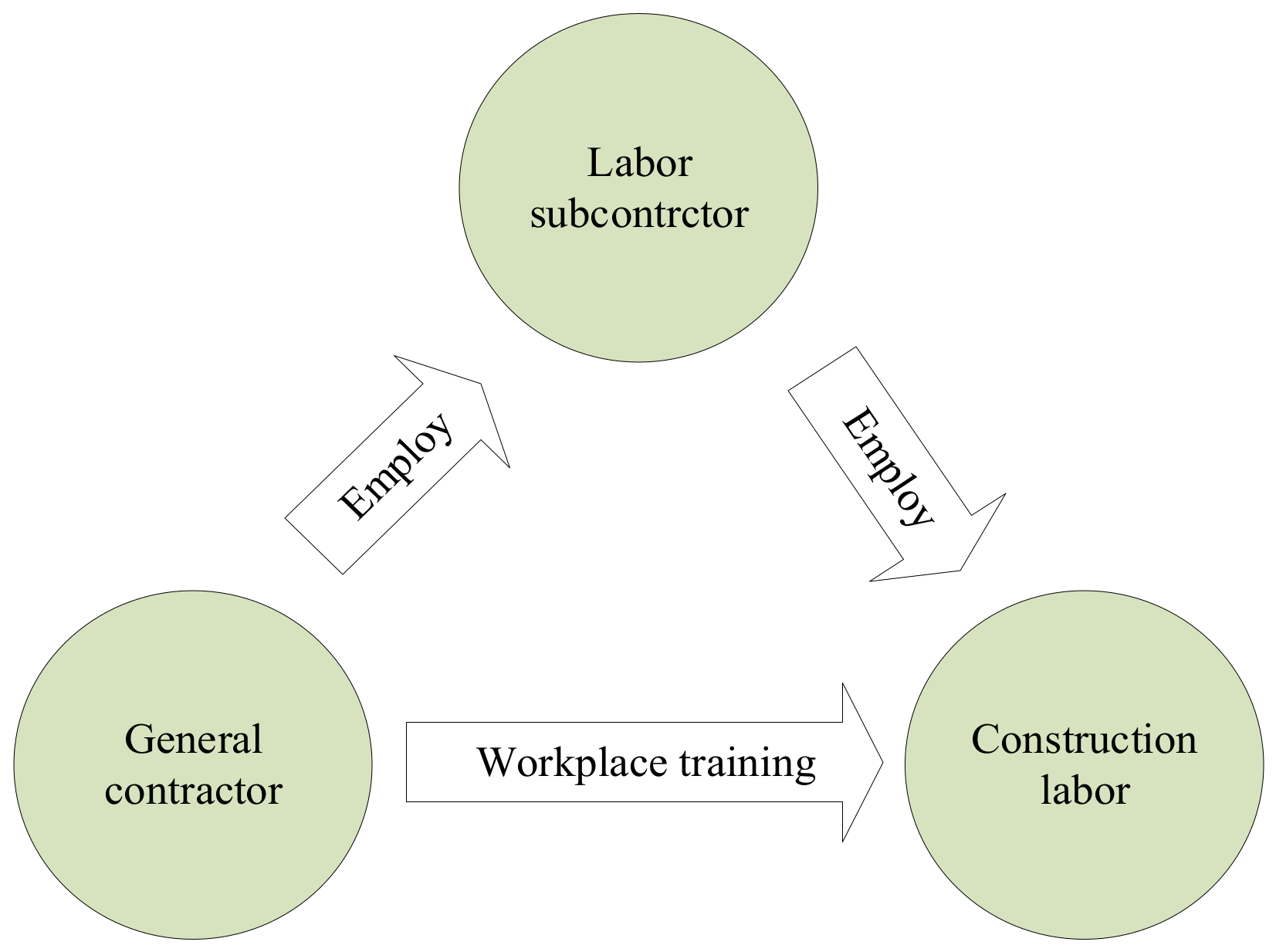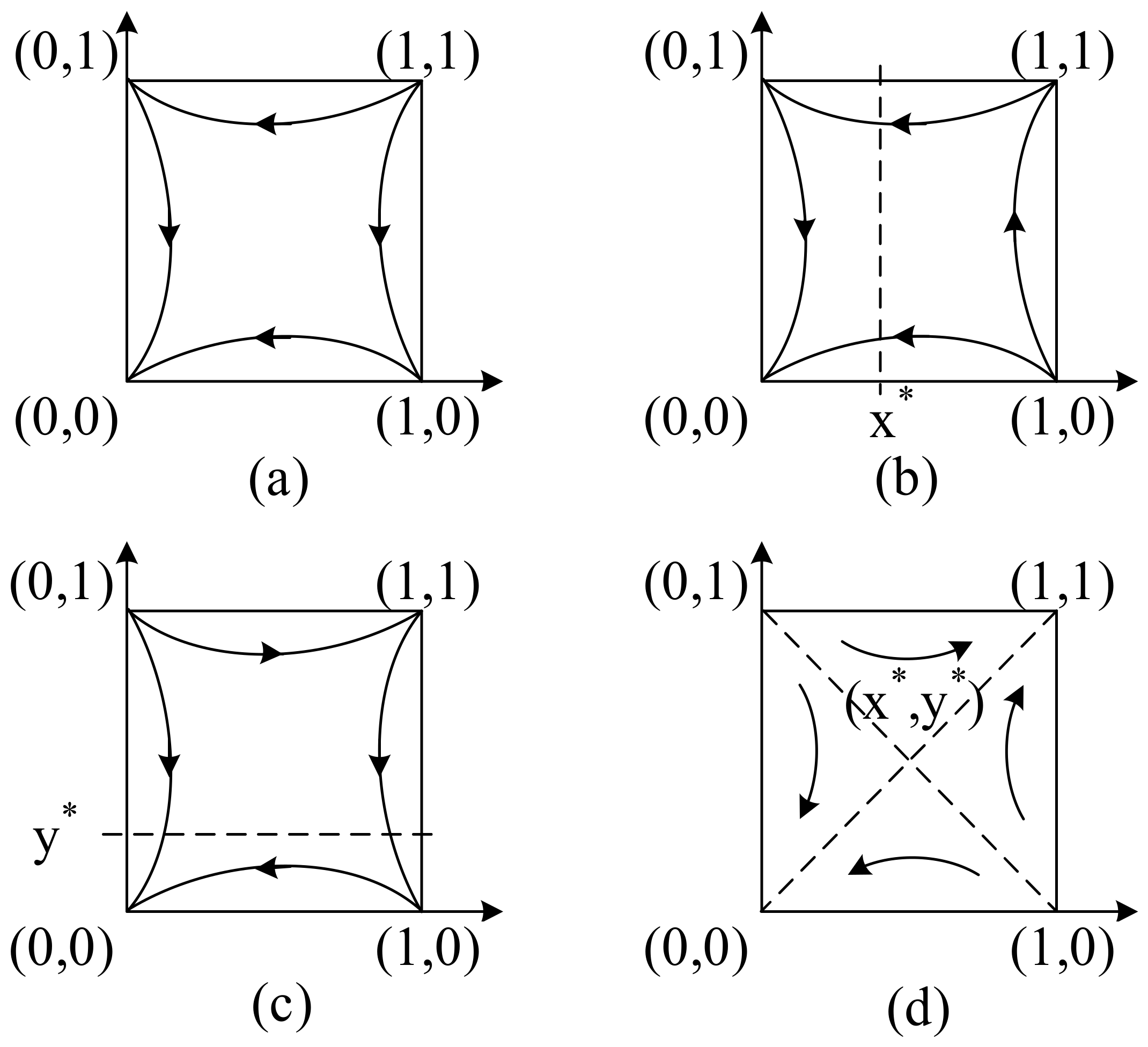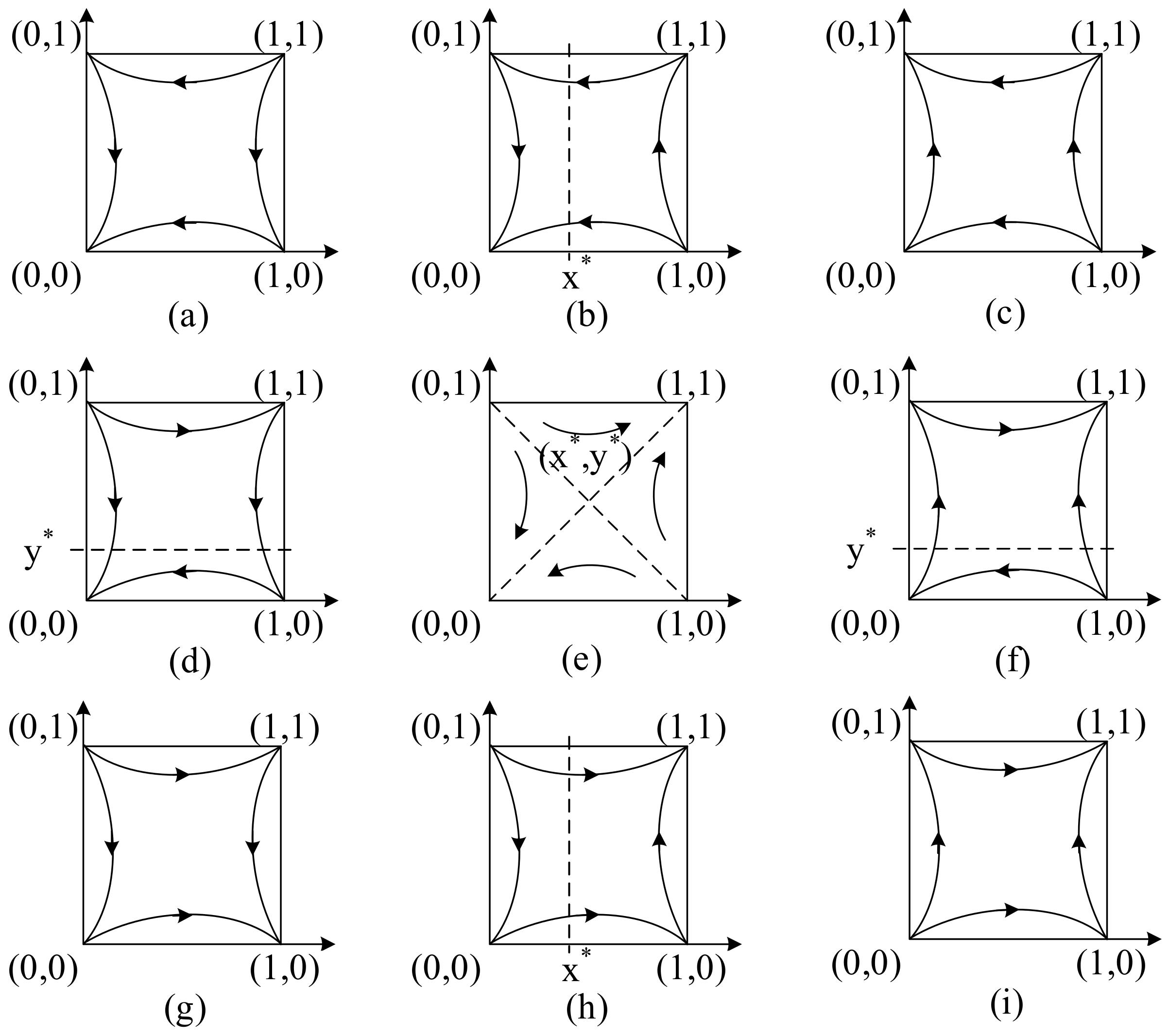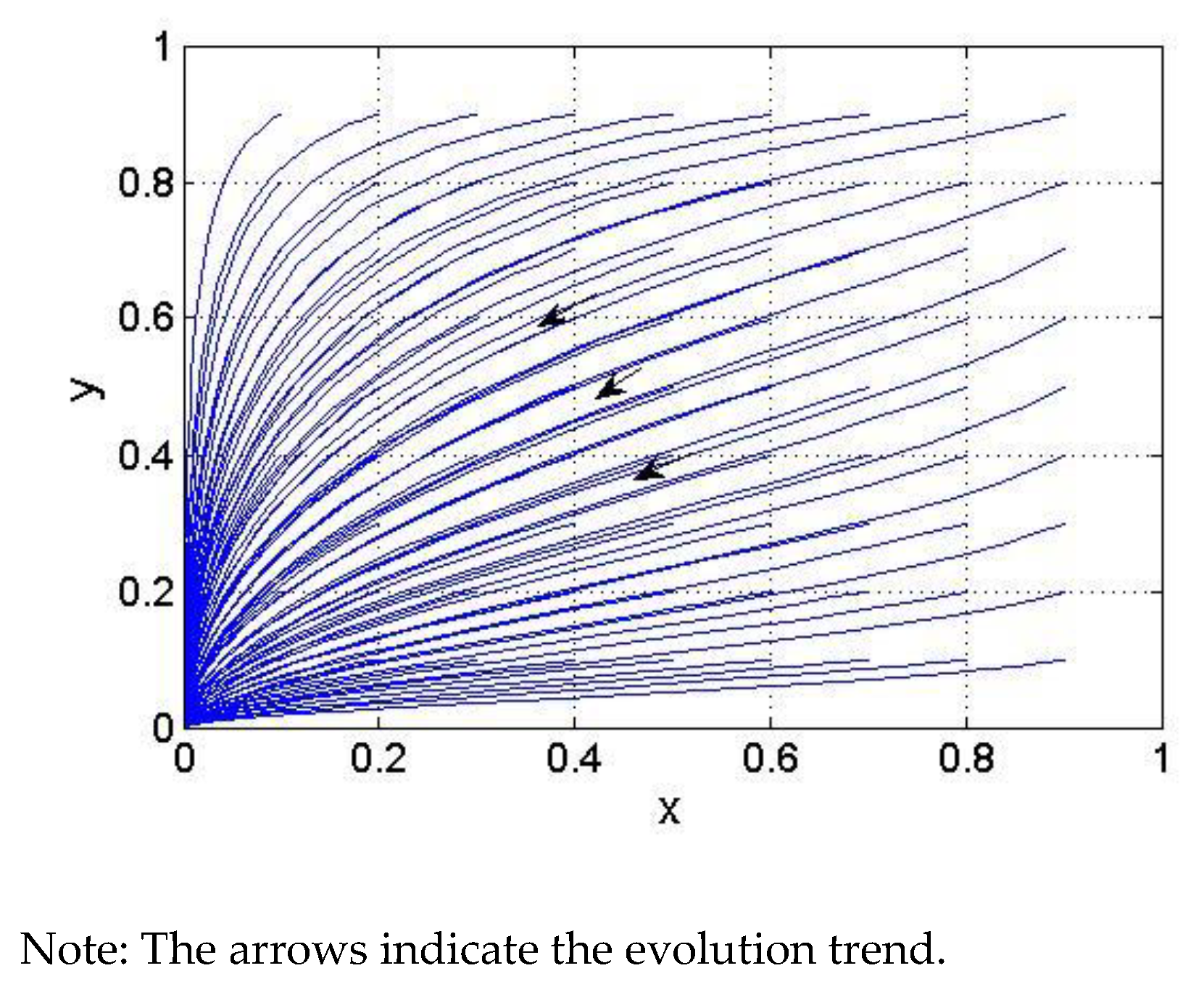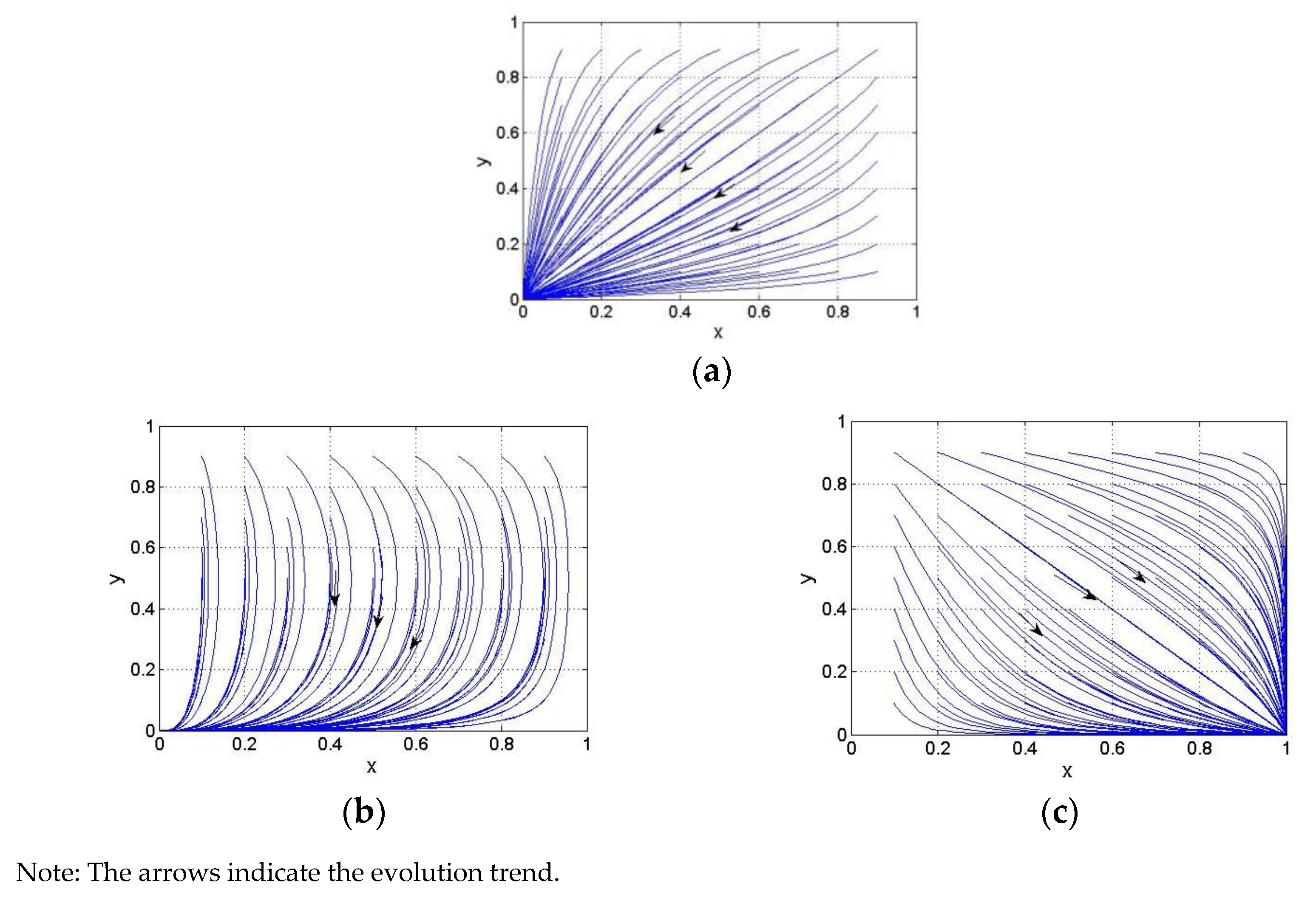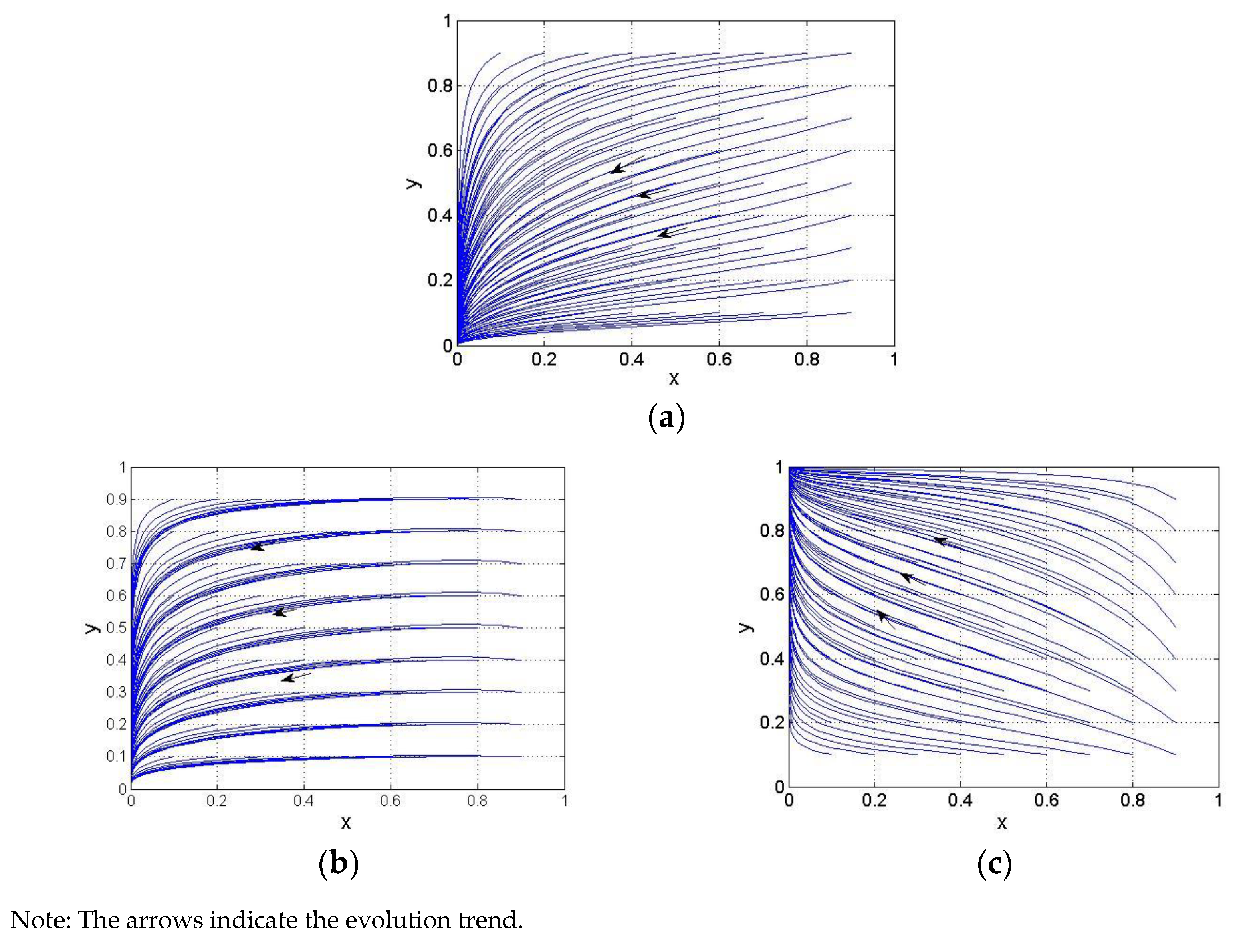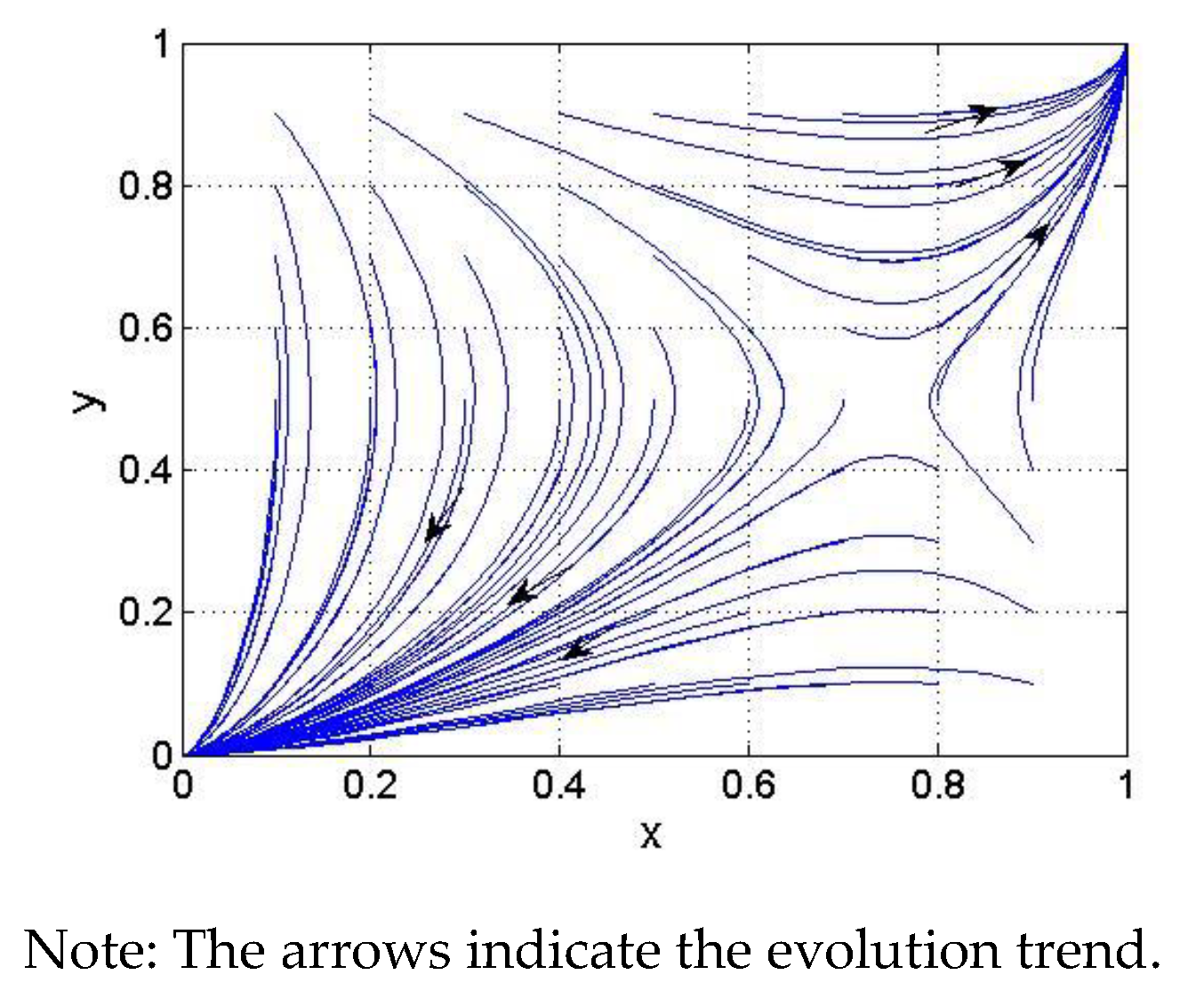4.1. Analysis of Evolutionary Game Model without Government Incentives
Based on the replicator dynamic equations, the “cooperation” strategy selected by general contractors
F(
x) and the “cultivating” strategy selected by labor subcontractors
F(
y) is as follows:
From Equations (7) and (8), set F(x) = 0, and F(y) = 0. (0,0), (0,1), (1,0), and (1,1) can be obtained as equilibrium points. When and hold, the formula F(x*) = 0 and F(y*) = 0 can be obtained, at the same time 0 < x* < 1, and 0 < y* < 1, in which , , so (x*,y*) is also an equilibrium point.
By calculating the determinant
and trace
of the Jacobian matrix, the above equilibrium points can be judged. If
and
, the equilibrium point is ESS. If
and
, the equilibrium point is unstable. Or else, the equilibrium point is the saddle point [
53].
The Jacobian matrix of the replicator dynamic equations is as follows:
Substitute the above five equilibrium points into Equation (9), their
det(J) and
tr(J) can be obtained, as shown in
Table 4.
According to the values of
, and
, the dynamic relationship and stability of replication between the two participants of the game under different conditions can be drawn, as shown in
Figure 2. Moreover, ESS under different conditions can be obtained.
Case 1: If and
In this case, both of the participants cannot obtain more benefits from cultivating a standard workforce. As a result, the game will gradually converge to the equilibrium point (0,0). The (not cooperation, not cultivating) strategy will be the only choice of the two populations. The local stability analyses of these equilibrium points are presented in
Table 5. The duplicated dynamic trend is depicted in
Figure 2a.
Case 2: If and
In this case, it means that the “cooperation” strategy of general contractors cannot obtain more benefit than the “not cooperation” strategy. Relatively, labor subcontractors can obtain more benefits from the “cultivating” strategy. However, due to the lack of general contractors’ support, the equilibrium point (0,0) is ESS. General contractors intend to employ contingent laborers, and labor subcontractors are reluctant to cultivate a standard workforce.
Table 6 represents the local stability analyses of these equilibrium points in case 2. The duplicated dynamic trend is depicted in
Figure 2b.
Case 3: If and
In this situation, general contractors will obtain more benefits from the strategy of “cooperation”. Otherwise, the choice of “not cultivating” can bring more revenue to labor subcontractors. Thus, the game will gradually converge to the equilibrium point (0,0). The local stability analyses of these equilibrium points are presented in
Table 7. The duplicated dynamic trend is illustrated in
Figure 2c.
Case 4: If and
In this case, equilibrium points (0,0) and (1,1) are the ESSes. It means that the two populations will make a choice between (not cooperation, not cultivating) and (cooperation, cultivating).
Table 8 presents the local stability analyses of these equilibrium points in case 8. The duplicated dynamic trend is depicted in
Figure 2d.
Based on the result, it shows that (not cooperation, not cultivating) is the main choice of the two participants in the construction labor market. Thus, the analysis results are consistent with the current situation in China.
In case 4, the probability of (cooperation, cultivating) being the ESS equals .
From the equation, it can be observed that increasing the punishment cost
and the benefit of employing a standard workforce
, or decreasing the cultivating cost
and
, will increase the growth probability of (cooperation, cultivating). Therefore, the government can promote the cultivation of a standard workforce by taking relevant measures, such as regulating the labor market to increase the cost of punishment
, improving the supervision of the quality of engineering projects to increase income by employing a standard workforce
and subside relative firms to decrease the cultivating cost
and
. Besides, the lack of direct government subsidies to the companies has made it difficult to increase the enthusiasm of both parties [
54]. The impact of government incentives is analyzed in the next section.
4.2. Evolutionary Game Model with Government Incentives
The government plays an important role in the construction skill-formation system [
19]. In this section, the authors analyze the effect of government incentives on the evolutionary processes. Based on the basic model, another assumption is presented.
Assumption 6. The government encourages relative firms to cultivate a standard workforce by providing subsidies. General contractors who employ a standard workforce will receive compensation Rg from the government. Besides, if labor subcontractors cultivate the workforce, some of this cost will be compensated by the government, assuming the compensation is Rl.
Then, according to assumptions 1–6 above, the payoff matrix of the evolutionary game between general contractors and labor subcontractors, with government incentives can be obtained, as presented in
Table 9.
When general contractors and labor subcontractors choose the strategy (cooperation, cultivating), general contractors can obtain , and labor subcontractors can obtain ; When general contractors and labor subcontractors choose the strategy (cooperation, not cultivating), general contractors can obtain , and labor subcontractors can obtain ; When general contractors and labor subcontractors choose the strategy (not cooperation, cultivating), general contractors can obtain , and labor subcontractors can obtain ; When general contractors and labor subcontractors choose the strategy (not cooperation, not cultivating), general contractors can obtain , and labor subcontractors can obtain .
The replicator dynamic equations of standard strategy selected by general contractors
and training strategy selected by labor subcontractors
are as follows:
From Equations (10) and (11), set
, and
. (0,0), (0,1), (1,0), and (1,1) can be obtained as equilibrium points. When
and
hold, the formula
and
can be obtained, at the same time, 0 <
< 1, and 0 <
< 1, where
,
, so (
,
) is also an equilibrium point. The same as the basic model, the Jacobian matrix of replicator dynamic equations can be calculated, as follows:
Substituting the above five equilibrium points into Equation (12),
det(J), and
tr(J) can be calculated, as shown in
Table 10.
Case 1 was to be used to test the impact of government incentives. In this case, the equilibrium point (0,0) is the ESS, that is, (not cooperation, not cultivating) is the choice of the general contractors and the labor subcontractors. Under this circumstance, there will be nine situations, as follows:
(1) When and
The (not cooperation, not cultivating) strategy will be the choice of the two populations. It means that the compensation to the general contractors and the labor subcontractors does not reach the expected result. The duplicated dynamic trend is presented in
Figure 3a.
(2) When and
With the compensation from the government, labor subcontractors are willing to choose to cultivate a standard workforce. However, compensation for general contractors is not enough to drive them in choosing a “cooperation” strategy. Due to the lack of a market, the system will converge to the equilibrium point (0,0).
Figure 3b shows the duplicated dynamic trend.
(3) When and
In this situation, the equilibrium point (0,1) is the ESS. It shows that the compensation for labor subcontractors who can cover the cost of cultivating a standard workforce, they will choose the strategy of “cultivating”, no matter whether general contractors participate or not.
Figure 3c displays the duplicated dynamic trend.
(4) When and
The strategy (not cooperation, not cultivating) will be the choice of the two populations. In this situation, general contractors are initially willing to cooperate with labor subcontractors on cultivating a standard workforce, while labor subcontractors lack motivation. As a result, the equilibrium point (0,0) is the ESS.
Figure 3d displays the duplicated dynamic trend.
(5) When and
The equilibrium point (0,0) and (1,1) are the ESSes. The compensation to the two populations can only mitigate the impact of risk to a certain extent. It indicates that general contractors and labor subcontractors will make a choice between (not cooperation, not cultivating) and (cooperation, cultivating). The duplicated dynamic trend is presented in
Figure 3e.
(6) When and
In this situation, under subsidized by the government, labor subcontractors have a strong willingness to cultivate a standard workforce. The system will converge to the equilibrium point (1,1).
Figure 3f shows the duplicated dynamic trend.
(7) When and
The system will converge to the equilibrium point (1,0). It means that the compensation from the government to general contractors is enough to cover the cost of participating in cultivating a standard workforce, even if labor subcontractors are reluctant to participate in it. However, it is difficult to achieve the desired result and will waste the government’s financial subsidies. The duplicated dynamic trend is presented in
Figure 3g.
(8) When and
The equilibrium point (1,1) is the ESS. In this situation, general contractors and labor subcontractors have a strong willingness to take part in establishing a long-term cooperation mechanism to cultivate a standard workforce.
Figure 3h shows the duplicated dynamic trend.
(9) When and
In this situation, the game will converge to the equilibrium point (1,1). General contractors and labor subcontractors are subsidized enough by the government to cover the cost of cooperating in cultivating a standard workforce. The duplicated dynamic trend is depicted in
Figure 3i.
It can be concluded that the government can drive general contractors and labor subcontractors to cultivate a standard workforce when the compensation reaches to a certain extent. Otherwise, if the compensation is not enough, it may only increase the government’s financial burden and fail to achieve the expected result. Furthermore, no matter how much the subsidy is to general contractors, as long as the subsidy to labor subcontractors reaches , labor subcontractors will cultivate a standard workforce. As a result, relatively speaking, it is more important to subsidize labor subcontractors rather than general contractors.
4.3. Numerical Simulations
To further analyze how the government influences the dynamic evolution process of general contractors and labor subcontractors when cultivating a standard workforce, this research uses MATLAB 2014a software to conduct numerical simulations. The (not cooperation, not cultivating) strategy is the most likely scenario. Therefore, the authors analyze how to promote the behavior of the two stakeholders to evolve into (cooperation, cultivating) strategy with government participation. Referring to the assignment method in literature [
55], the initial value of variables is set as shown in
Table 11.
The initial values of x and y are set to 0.9, and the change steps of x and y are set to 0.1. The strategy evolution of the two stakeholders is shown in
Figure 4.
From
Figure 4, it can be found that regardless of the initial values of
x and
y, the strategies of general contractors and labor subcontractors will eventually evolve into strategy (not cooperation, not cultivating). In other words, the initial strategy of the two participants has no impact on the final choice (not cooperation, not cultivating). Therefore, without government participation, their ultimate strategic choice would be not to participate in cultivating a standard workforce.
In order to analyze the impact of government participation on the evolution process and investigate which strategies the government adopts can effectively promote the cultivation of a standard workforce, this study will simulate the evolution results of different strategies adopted by the government. According to the parameter values set in
Table 11, it can be obtained that
,
, and
. Thus, set
,
,
and
,
,
to analyze the impact of government incentives on evolutionary outcomes.
(1) The impact of government incentives on general contractors
Set the subsidy for labor subcontractors to 0, and the subsidy intensity for general contractors is respectively
,
and
. The evolution results are shown in
Figure 5.
- (a)
When the government’s subsidy to general contractors is , due to the low subsidy amount, the final strategy choice for general contractors and labor subcontractors is (not cooperation, not cultivating);
- (b)
When the government’s subsidy to general contractors is , subsidy amount meets . General contractors are willing to cultivate a standard workforce, but due to the unwillingness of labor subcontractors to participate in cultivating a standard workforce, the ultimate strategy choice for both parties is (not cooperation, not cultivating);
- (c)
When the government’s subsidy to general contractors is , subsidy amount meets . Due to the high subsidy amount, general contractors will no longer consider whether labor subcontractors will participate or not, and will make the “cooperation “strategy become their only choice. Without subsidies, labor subcontractors will not participate in the cultivation activity, resulting in the strategic choice of both parties being (cooperation, not cultivating). At this point, it will create the illusion of cultivating a standard workforce, while the cultivation activities have not really carried out. As a result, it will cause an excessive financial burden on the government and a loss of financial resources.
(2) The impact of government incentives on labor subcontractors
Set the subsidy for general contractors to 0, and the subsidy intensity for labor subcontractors is respectively
,
and
. The evolution results are shown in
Figure 6.
- (a)
When the government’s subsidy to labor subcontractors is , due to the low subsidy amount, the final strategy choice for general contractors and labor subcontractors is (not cooperation, not cultivating);
- (b)
When the government’s subsidy to labor subcontractors is , subsidy amount meets . Labor subcontractors are willing to cultivate a standard workforce, but due to the unwillingness of general contractors to participate in cultivating a standard workforce, the ultimate strategy choice for both parties is (not cooperation, not cultivating);
- (c)
When the government’s subsidy to labor subcontractors is , subsidy amount meets . Due to the high subsidy amount, labor subcontractors no longer consider the strategic choice behavior of general contractors and will insist on “cultivating” strategy. Without subsidies, general contractors will not participate in the cultivation of a standard workforce, resulting in the ultimate strategic choice of both parties being (not cooperation, cultivating). At this point, despite the lack of participation of general contractors, in reality, labor subcontractors have carried out cultivation activities, which can achieve the goal of cultivating a standard workforce.
(3) The impact of government incentives on both general contractors and labor subcontractors
When the subsidy amount is too high or too low, it will cause one party in the game to no longer consider the strategic behavior of the other party. Thus, the authors will analyze the strategic evolution process of general contractors and labor subcontractors, when
and
. Set the subsidy for general contractors at
, and the subsidy intensity for labor subcontractors at
. The evolution results are shown in
Figure 7.
From
Figure 7, general contractors and labor subcontractors will make choices between (not cooperation, not cultivating) and (cooperation, cultivating) strategies. Besides, the process of strategy evolution for both parties will be closely related to the degree of willingness. When one party is unwilling to participate in cultivating a standard workforce, it will greatly dampen the enthusiasm of the other one to participate. Conversely, when one party has a greater willingness to cultivate a standard workforce, it can enhance the motivation of the other one to participate in cultivation.
